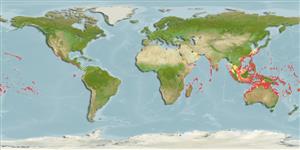Actinopterygii (ray-finned fishes) >
Scorpaeniformes (Scorpionfishes and flatheads) >
Scorpaenidae (Scorpionfishes or rockfishes) > Pteroinae
Etymology: Dendrochirus: Greek, dendron = tree + Greek, cheir = hands; with tree like marks (Ref. 45335).
Environment / Climate / Range
Ecology
Marine; reef-associated; depth range 2 - 80 m (Ref. 90102). Tropical, preferred ?; 32°N - 32°S
Indo-West Pacific: Red Sea and East Africa to Samoa and Tonga, north to southern Japan, south to Lord Howe Island; Mariana Islands in Micronesia; the Arafura Sea (Ref. 9819) and Australia.
Size / Weight / Age
Maturity: Lm ? range ? - ? cm
Max length : 17.0 cm TL male/unsexed; (Ref. 9710)
Common in reef flats and shallow lagoons, in areas with weed-covered rocks on sandy substrates. Adults often found on sponges and juveniles are sometimes found in small aggregations on remote bommies with 10 or so individuals (Ref. 48635). Nocturnal. Feeds on small crustaceans (Ref. 37816).
Life cycle and mating behavior
Maturity | Reproduction | Spawning | Eggs | Fecundity | Larvae
Distinct pairing (Ref. 205). Females possess specialized ovarian structures including stalk-like ovigerous lamellae and secretory epithelia (Ref. 32832).
Eschmeyer, W.N., 1986. Scorpaenidae. p. 463-478. In M.M. Smith and P.C. Heemstra (eds.) Smiths' sea fishes. Springer-Verlag, Berlin. (Ref. 4313)
IUCN Red List Status (Ref. 115185)
CITES (Ref. 94142)
Not Evaluated
Human uses
Fisheries: subsistence fisheries; aquarium: commercial
More information
ReferencesAquacultureAquaculture profileStrainsGeneticsAllele frequenciesHeritabilityDiseasesProcessingMass conversion
Tools
Special reports
Download XML
Internet sources
